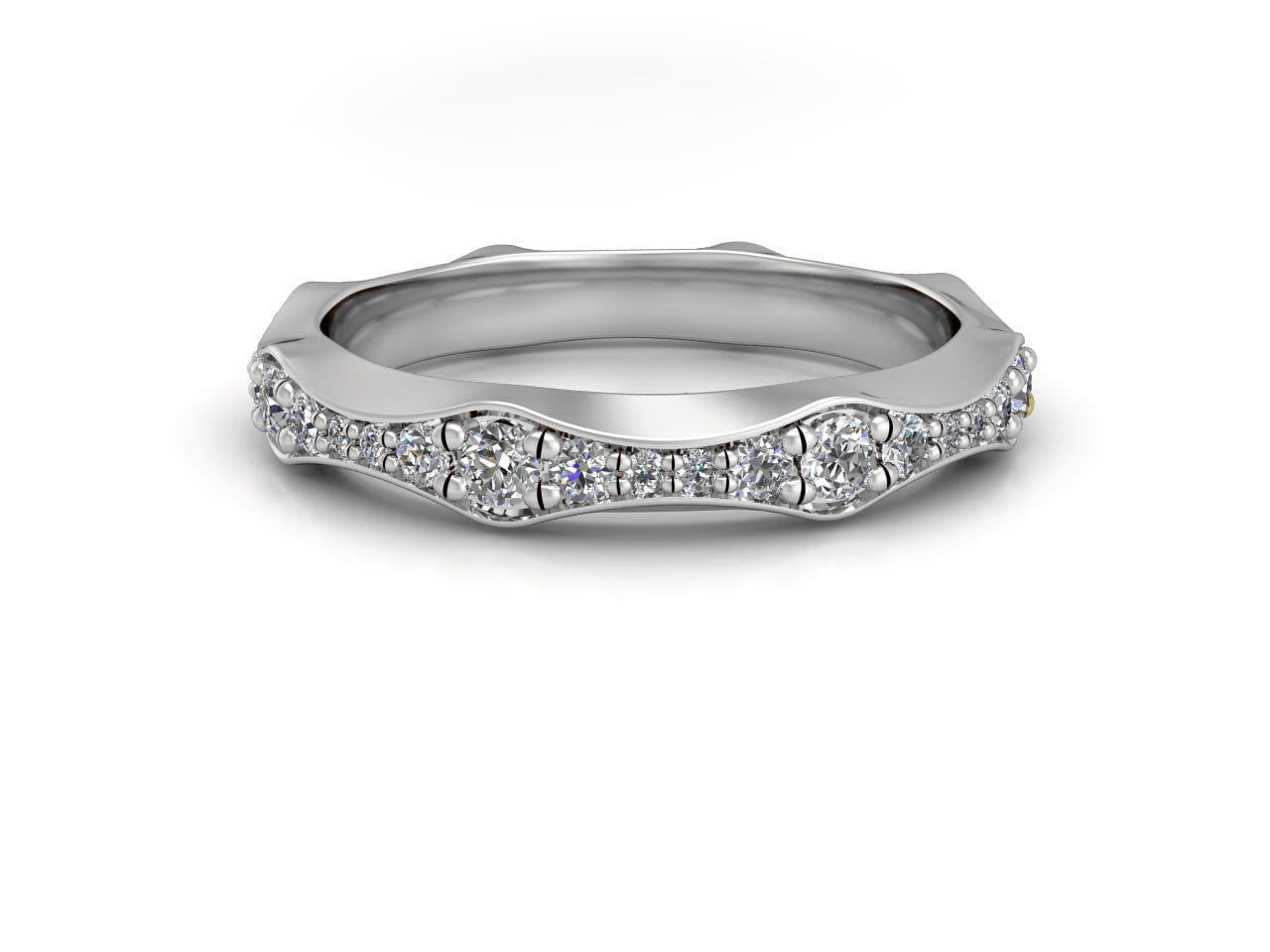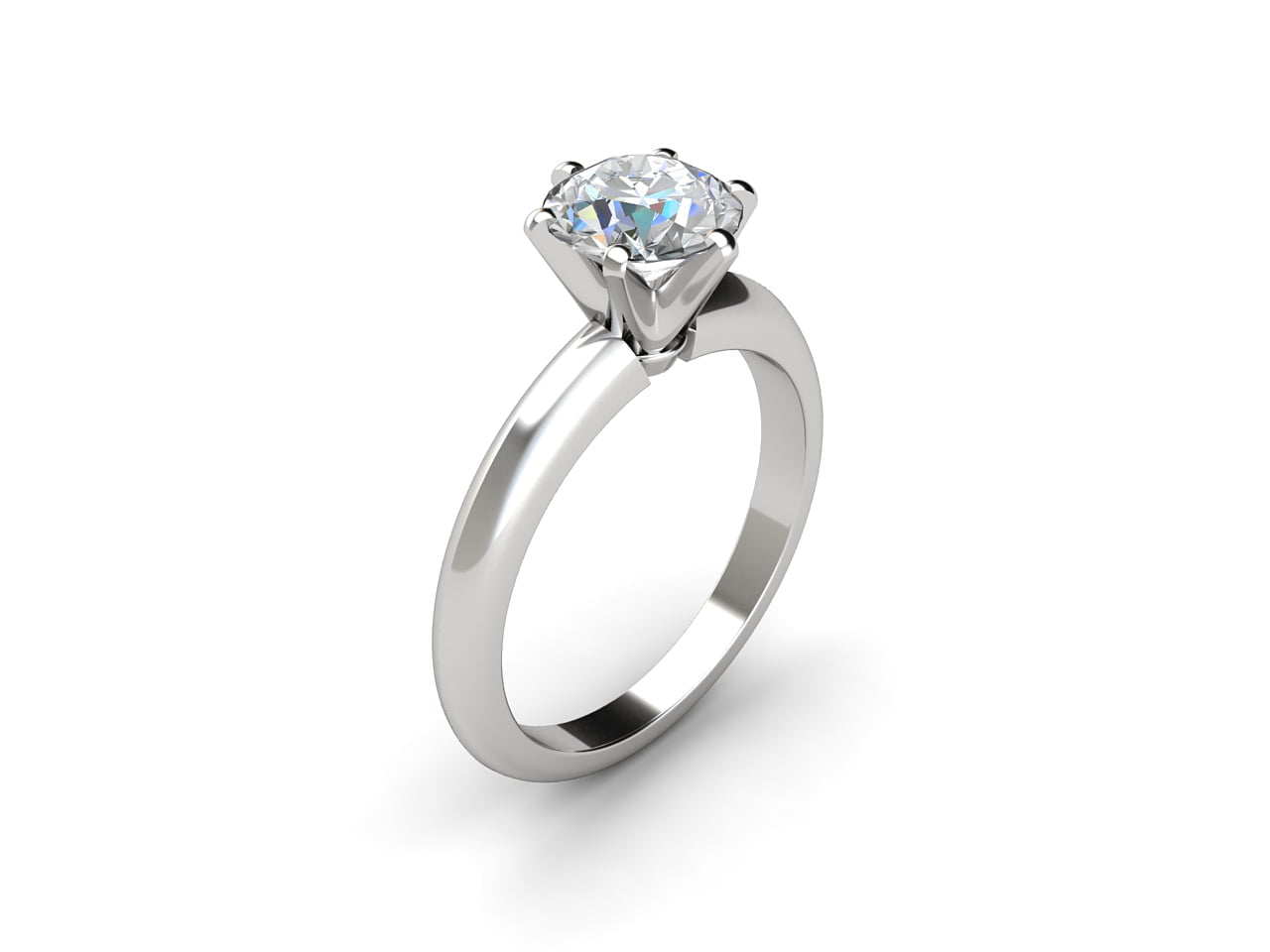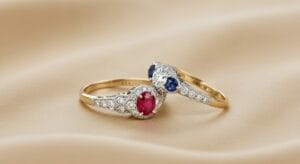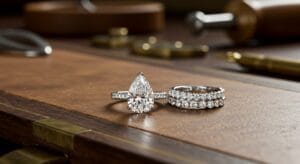Understanding the Round Brilliant Cut in the History of Diamond Cuts
In this blog post series, we will delve into the fascinating history of diamond cuts, examining how they have evolved and their significance.
Exploring the Emerald Cut
Understanding the history of diamond cuts enriches our appreciation for each design, from the earliest creations to the most contemporary styles.
The emerald cut is distinctively different from the brilliant cut. With its rectangular shape and step-cut facets, it exudes a sophisticated, vintage appeal within the broader history of diamond cuts. The cut’s unique geometry allows for a transparent view into the diamond, showcasing its clarity and colour.
Emerald cut diamonds are often set in elegant, understated settings that highlight the stone’s unique beauty. The cut is less about sparkle and more about the diamond’s clarity and colour, making it an excellent choice for those who appreciate these qualities.
When choosing an emerald cut, consider the diamond’s proportions and select one with high clarity, as inclusions can be more visible in this cut style. The emerald cut’s timeless elegance makes it a popular choice for classic engagement rings.
The princess cut has a special place in the history of diamond cuts, representing a blend of innovation and timeless appeal.
The Allure of the Princess Cut
The princess cut has gained immense popularity since its introduction in the late 20th century. Known for its contemporary style and stunning light performance, many modern brides favour it. The cut features sharp corners and a square or rectangular shape, which can enhance both the diamond’s brilliance and its size appearance.
One of the advantages of a princess cut is its versatility. It can easily be set in various styles, from classic solitaires to elaborate multi-stone designs. Many couples are drawn to its modern aesthetic, which complements a wide range of engagement ring styles.
Throughout the history of diamond cuts, the pear cut has also become a sought-after choice, admired for its unique silhouette.
When purchasing a princess-cut diamond, it’s essential to focus on the cut quality, as this will significantly influence the light dispersion and overall sparkle of the stone. Factors such as symmetry and polish are paramount in determining the diamond’s brilliance.
Diving Deeper into the Pear-Cut
The pear cut is often described as the ‘teardrop’ shape, and it is a favourite choice for individuals looking for something unique that still holds a sense of classic elegance. Its silhouette combines the best features of the round brilliant and marquise cuts, offering a striking yet graceful appearance.
With the round brilliant cut being a staple in the history of diamond cuts, its design continues to influence modern styles.
The pear’s unique shape allows for versatility in settings. It can be set in a standard solitaire style or surrounded by accent stones, creating a more dramatic effect. The placement of the stone can also influence how it is worn; some choose to wear the point facing down, while others prefer the rounded side facing down.
When selecting a pear-shaped diamond, symmetry is particularly important. A well-proportioned pear cut will exhibit a balanced appearance, which is crucial for optimal light performance. This cut can also vary in length-to-width ratio, which can affect its overall look and feel.
The round brilliant cut is not only the most popular but also one of the most studied diamond cuts in the world. Its design maximises sparkle and fire, making it a preferred choice for those seeking an engagement ring that dazzles. The cut’s 58 facets work in unison to reflect light, creating an illusion of depth and brilliance.
The history of diamond cuts truly reflects the artistry and craftsmanship that have evolved over centuries.
Each era tells a different chapter in the history of diamond cuts, showcasing how tastes and technologies have shifted.
This evolution in the history of diamond cuts illustrates the growing appreciation for beauty alongside strength.
When purchasing a round brilliant diamond, it’s crucial to consider the 4Cs: cut, colour, clarity, and carat weight. Each of these factors contributes to the overall quality and appearance of the diamond. A well-cut diamond will reflect light beautifully, while a poorly cut one may appear dull despite its size.
Additionally, the choice of setting can significantly enhance the appearance of a round brilliant diamond. For instance, a solitaire setting places the diamond front and centre, allowing its brilliance to shine without distraction. On the other hand, a halo setting encircles the centre stone with smaller diamonds, amplifying the overall sparkle.
When browsing engagement rings, it’s easy to be mesmerised by the dazzling brilliance of each diamond and overlook the rich history of diamond cuts that go into creating these timeless treasures. Diamond cutting, an art form that has evolved over centuries, has resulted in various intricate and stunning designs in our engagement ring collection, each with its unique historical significance.
Round Brilliant-Cut
 The round brilliant cut featured in our exquisite Marina engagement ring is arguably the most classic and well-known diamond shape.
The round brilliant cut featured in our exquisite Marina engagement ring is arguably the most classic and well-known diamond shape.Designed to maximise a diamond’s brilliance, this cut boasts 58 precise facets that beautifully reflect light. Its roots date back to the 17th century when the Mazarin technique was introduced, revolutionising diamond cutting for enhanced sparkle.
Step into the world of timeless elegance with the round brilliant cut in our Marina engagement ring. This classic cut, featured in our exquisite Marina engagement ring, is designed to maximise a diamond’s brilliance, boasting 58 precise facets that beautifully reflect light.
Pear-Cut
 The pear cut, showcased in our elegant Xanthe engagement ring, is a striking blend of brilliant and marquise cuts, resulting in a stunning teardrop shape.
The pear cut, showcased in our elegant Xanthe engagement ring, is a striking blend of brilliant and marquise cuts, resulting in a stunning teardrop shape.This unique cut can be traced back to the 15th century, thanks to the innovation of Flemish jeweller Lodewyk van Bercken, who also pioneered the scarf, a crucial diamond-polishing tool.
In the Xanthe engagement ring, a captivating pear-shaped diamond is embraced by a halo of round brilliant diamonds, adding an enchanting allure.
Princess-Cut
 The Eris engagement ring is a perfect choice for a design that is both modern and regal. It showcases the dazzling princess cut.
The Eris engagement ring is a perfect choice for a design that is both modern and regal. It showcases the dazzling princess cut.The princess cut is a dazzling cut with bevelled sides, allowing light to disperse throughout the gem. It was developed in the early 1970s as an evolution of the Barion cut. In 1979, Israeli Jewellers Ygal Perlman, Betzalel Ambar, and Israel Itzkowitz created the princess cut after careful research.
Our beautiful Eris ring features a magnificent princess-cut diamond and two alluring trapezoid-cut diamonds, offering a bold and glamorous look.
Emerald-Cut

The Themis engagement ring highlights the timeless beauty of the emerald cut.
This sophisticated cut originated in the 1500s with the table cut, but today’s refined version rose to popularity during the Art Deco period of the 1920s. With its unique step-cut design and flat top, the emerald cut emphasises clarity and creates a mesmerising hall-of-mirrors effect.
The Themis ring showcases this elegant design, adding a vintage touch with a modern twist.
If you need help finding the perfect diamond cut, we’re here to help at Joseph George Jewellers. You can visit the store to browse our collection or contact us online to learn more.
This period in the history of diamond cuts represents a convergence of artistic expression and scientific understanding.
In contemporary times, the history of diamond cuts continues to inspire innovations that captivate gemstone enthusiasts.
As you engage with our collection, remember the rich history of diamond cuts that each piece embodies.
At Joseph George Jewellers, we celebrate the history of diamond cuts, ensuring every piece reflects both beauty and legacy.
The History of Diamond Cuts: An Overview
Understanding the history of diamond cuts is essential for appreciating how these precious stones have evolved. From rudimentary shapes to the highly refined cuts we see today, each phase in the evolution of diamond cutting tells a story of innovation and artistry.
In ancient times, diamonds were used primarily for their hardness and were believed to have mystical properties, rather than for their beauty. The earliest known diamonds were found in India, where they were collected from riverbeds. These diamonds were shaped by nature rather than human intervention, often possessing an unpolished, raw look.
As trade expanded, particularly during the Middle Ages, diamonds began to be valued not only for their strength but also for their aesthetic appeal. The introduction of polishing techniques allowed gem cutters to explore new designs, leading to the creation of simple shapes, such as the table cut and the point cut.
The Renaissance period marked a significant turning point in diamond cutting, driven by technological advancements and changing tastes among the elite. This era saw the birth of the rose cut, characterised by its flat underside and a domed top adorned with triangular facets, offering a delicate sparkle.
As we moved into the 17th century, the Mazarin cut emerged, laying the groundwork for the brilliant cut we cherish today. This pivotal moment in diamond cutting history illustrated the growing importance of light reflection and brilliance in design.
By the 18th and 19th centuries, diamond cutting became a recognised art form, with skilled craftsmen in Europe pushing boundaries and creating increasingly intricate designs. The introduction of the modern brilliant cut in the early 20th century, perfected by Marcel Tolkowsky, represented the culmination of centuries of experimentation and expertise.
Today, diamond cutting is a blend of tradition and technology, with computer-aided design (CAD) enabling the creation of precise and complex cuts that enhance a diamond’s beauty. This blend of history and modernity continues to shape the engagement ring market, where each cut carries a legacy and a story.
Embracing the Legacy of Diamond Cuts
The world of diamond cuts is a testament to human ingenuity and artistry. Each cut carries a story, a history that reflects the evolution of societal values and aesthetic preferences. As you explore the enchanting world of engagement rings, remember that the diamond’s cut is not just a design choice; it’s a reflection of its journey through time. At Joseph George Jewellers, we ensure that every diamond in our collection embodies this legacy, offering you not only beauty but also a piece of the rich history that continues to inspire.








